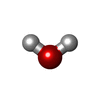+ Open data
Open data
- Basic information
Basic information
| Entry | Database: PDB / ID: 9n1f | ||||||
|---|---|---|---|---|---|---|---|
| Title | Crystal Structure of the Ark2C-Ubc13~Ub-Mms2 complex | ||||||
 Components Components |
| ||||||
 Keywords Keywords | TRANSFERASE / RING E3 ligase Ubiquitin PTM / LIGASE / E2~Ub conjugate | ||||||
| Function / homology |  Function and homology information Function and homology informationmuscle structure development / forelimb morphogenesis / error-free postreplication DNA repair / UBC13-MMS2 complex / ubiquitin conjugating enzyme complex / ubiquitin-protein transferase activator activity / positive regulation of protein K63-linked ubiquitination / DNA double-strand break processing / positive regulation of BMP signaling pathway / motor neuron axon guidance ...muscle structure development / forelimb morphogenesis / error-free postreplication DNA repair / UBC13-MMS2 complex / ubiquitin conjugating enzyme complex / ubiquitin-protein transferase activator activity / positive regulation of protein K63-linked ubiquitination / DNA double-strand break processing / positive regulation of BMP signaling pathway / motor neuron axon guidance / DNA damage tolerance / innervation / E2 ubiquitin-conjugating enzyme / positive regulation of double-strand break repair / ubiquitin conjugating enzyme activity / positive regulation of intracellular signal transduction / protein K63-linked ubiquitination / protein monoubiquitination / ubiquitin ligase complex / regulation of DNA repair / negative regulation of TORC1 signaling / Maturation of protein E / Maturation of protein E / ER Quality Control Compartment (ERQC) / Myoclonic epilepsy of Lafora / FLT3 signaling by CBL mutants / Constitutive Signaling by NOTCH1 HD Domain Mutants / IRAK2 mediated activation of TAK1 complex / Prevention of phagosomal-lysosomal fusion / Alpha-protein kinase 1 signaling pathway / Glycogen synthesis / IRAK1 recruits IKK complex / IRAK1 recruits IKK complex upon TLR7/8 or 9 stimulation / antiviral innate immune response / Endosomal Sorting Complex Required For Transport (ESCRT) / Membrane binding and targetting of GAG proteins / Negative regulation of FLT3 / Regulation of TBK1, IKKε (IKBKE)-mediated activation of IRF3, IRF7 / PTK6 Regulates RTKs and Their Effectors AKT1 and DOK1 / Regulation of TBK1, IKKε-mediated activation of IRF3, IRF7 upon TLR3 ligation / IRAK2 mediated activation of TAK1 complex upon TLR7/8 or 9 stimulation / NOTCH2 Activation and Transmission of Signal to the Nucleus / TICAM1,TRAF6-dependent induction of TAK1 complex / TICAM1-dependent activation of IRF3/IRF7 / APC/C:Cdc20 mediated degradation of Cyclin B / Downregulation of ERBB4 signaling / Regulation of FZD by ubiquitination / APC-Cdc20 mediated degradation of Nek2A / p75NTR recruits signalling complexes / InlA-mediated entry of Listeria monocytogenes into host cells / TRAF6 mediated IRF7 activation in TLR7/8 or 9 signaling / TRAF6-mediated induction of TAK1 complex within TLR4 complex / Regulation of pyruvate metabolism / NF-kB is activated and signals survival / Regulation of innate immune responses to cytosolic DNA / Pexophagy / Downregulation of ERBB2:ERBB3 signaling / NRIF signals cell death from the nucleus / Regulation of PTEN localization / Activated NOTCH1 Transmits Signal to the Nucleus / VLDLR internalisation and degradation / positive regulation of DNA repair / Regulation of BACH1 activity / Synthesis of active ubiquitin: roles of E1 and E2 enzymes / MAP3K8 (TPL2)-dependent MAPK1/3 activation / Translesion synthesis by REV1 / TICAM1, RIP1-mediated IKK complex recruitment / ubiquitin binding / Translesion synthesis by POLK / InlB-mediated entry of Listeria monocytogenes into host cell / Activation of IRF3, IRF7 mediated by TBK1, IKKε (IKBKE) / JNK (c-Jun kinases) phosphorylation and activation mediated by activated human TAK1 / Josephin domain DUBs / Downregulation of TGF-beta receptor signaling / Translesion synthesis by POLI / IKK complex recruitment mediated by RIP1 / Gap-filling DNA repair synthesis and ligation in GG-NER / Regulation of activated PAK-2p34 by proteasome mediated degradation / PINK1-PRKN Mediated Mitophagy / TGF-beta receptor signaling in EMT (epithelial to mesenchymal transition) / TNFR1-induced NF-kappa-B signaling pathway / Autodegradation of Cdh1 by Cdh1:APC/C / TCF dependent signaling in response to WNT / APC/C:Cdc20 mediated degradation of Securin / Regulation of NF-kappa B signaling / N-glycan trimming in the ER and Calnexin/Calreticulin cycle / activated TAK1 mediates p38 MAPK activation / Asymmetric localization of PCP proteins / Ubiquitin-dependent degradation of Cyclin D / SCF-beta-TrCP mediated degradation of Emi1 / NIK-->noncanonical NF-kB signaling / TNFR2 non-canonical NF-kB pathway / Regulation of signaling by CBL / AUF1 (hnRNP D0) binds and destabilizes mRNA / NOTCH3 Activation and Transmission of Signal to the Nucleus / Negative regulators of DDX58/IFIH1 signaling / Vpu mediated degradation of CD4 / Assembly of the pre-replicative complex / Ubiquitin-Mediated Degradation of Phosphorylated Cdc25A / Deactivation of the beta-catenin transactivating complex Similarity search - Function | ||||||
| Biological species |  Homo sapiens (human) Homo sapiens (human) | ||||||
| Method |  X-RAY DIFFRACTION / X-RAY DIFFRACTION /  SYNCHROTRON / SYNCHROTRON /  MOLECULAR REPLACEMENT / Resolution: 2.1 Å MOLECULAR REPLACEMENT / Resolution: 2.1 Å | ||||||
 Authors Authors | Paluda, A. / Middleton, A.J. / Day, C.L. | ||||||
| Funding support |  New Zealand, 1items New Zealand, 1items
| ||||||
 Citation Citation |  Journal: J.Mol.Biol. / Year: 2025 Journal: J.Mol.Biol. / Year: 2025Title: Arkadia and Ark2C Promote Substrate Ubiquitylation with Multiple E2 Enzymes. Authors: Rossig, C. / Paluda, A. / Chen, R. / Middleton, A.J. / Day, C.L. | ||||||
| History |
|
- Structure visualization
Structure visualization
| Structure viewer | Molecule:  Molmil Molmil Jmol/JSmol Jmol/JSmol |
|---|
- Downloads & links
Downloads & links
- Download
Download
| PDBx/mmCIF format |  9n1f.cif.gz 9n1f.cif.gz | 103.5 KB | Display |  PDBx/mmCIF format PDBx/mmCIF format |
|---|---|---|---|---|
| PDB format |  pdb9n1f.ent.gz pdb9n1f.ent.gz | 76.9 KB | Display |  PDB format PDB format |
| PDBx/mmJSON format |  9n1f.json.gz 9n1f.json.gz | Tree view |  PDBx/mmJSON format PDBx/mmJSON format | |
| Others |  Other downloads Other downloads |
-Validation report
| Summary document |  9n1f_validation.pdf.gz 9n1f_validation.pdf.gz | 1.1 MB | Display |  wwPDB validaton report wwPDB validaton report |
|---|---|---|---|---|
| Full document |  9n1f_full_validation.pdf.gz 9n1f_full_validation.pdf.gz | 1.1 MB | Display | |
| Data in XML |  9n1f_validation.xml.gz 9n1f_validation.xml.gz | 21 KB | Display | |
| Data in CIF |  9n1f_validation.cif.gz 9n1f_validation.cif.gz | 27.8 KB | Display | |
| Arichive directory |  https://data.pdbj.org/pub/pdb/validation_reports/n1/9n1f https://data.pdbj.org/pub/pdb/validation_reports/n1/9n1f ftp://data.pdbj.org/pub/pdb/validation_reports/n1/9n1f ftp://data.pdbj.org/pub/pdb/validation_reports/n1/9n1f | HTTPS FTP |
-Related structure data
| Similar structure data | Similarity search - Function & homology  F&H Search F&H Search |
|---|
- Links
Links
- Assembly
Assembly
| Deposited unit | 
| ||||||||
|---|---|---|---|---|---|---|---|---|---|
| 1 |
| ||||||||
| Unit cell |
|
- Components
Components
-Protein , 2 types, 2 molecules AD
| #1: Protein | Mass: 9859.214 Da / Num. of mol.: 1 Source method: isolated from a genetically manipulated source Details: GPLGS residues remained after the N-terminal tag cleavage. N-terminal residues 1-254 were truncated. Deletion of residues 273-282. Two zinc ions coordinated. Source: (gene. exp.)  Homo sapiens (human) / Gene: ARK2C, RNF165 / Production host: Homo sapiens (human) / Gene: ARK2C, RNF165 / Production host:  References: UniProt: Q6ZSG1, RING-type E3 ubiquitin transferase |
|---|---|
| #4: Protein | Mass: 8576.831 Da / Num. of mol.: 1 Source method: isolated from a genetically manipulated source Details: C-terminal Gly76 is linked to the Lys87 of Ubc13 (chain B) via a isopeptide bond. Source: (gene. exp.)  Homo sapiens (human) / Gene: UBC / Production host: Homo sapiens (human) / Gene: UBC / Production host:  |
-Ubiquitin-conjugating enzyme E2 ... , 2 types, 2 molecules BC
| #2: Protein | Mass: 17566.135 Da / Num. of mol.: 1 / Mutation: C87K, K92T, K94Q Source method: isolated from a genetically manipulated source Details: GPLGS remained after the tag N-terminal removal. Lys87 is covalently connected to the C terminal Gly76 of chain D via an isopeptide bond. Source: (gene. exp.)  Homo sapiens (human) / Gene: UBE2N, BLU / Production host: Homo sapiens (human) / Gene: UBE2N, BLU / Production host:  References: UniProt: P61088, E2 ubiquitin-conjugating enzyme |
|---|---|
| #3: Protein | Mass: 16364.731 Da / Num. of mol.: 1 / Mutation: S32A Source method: isolated from a genetically manipulated source Source: (gene. exp.)  Homo sapiens (human) / Gene: UBE2V2, MMS2, UEV2 / Production host: Homo sapiens (human) / Gene: UBE2V2, MMS2, UEV2 / Production host:  |
-Non-polymers , 2 types, 66 molecules 


| #5: Chemical | | #6: Water | ChemComp-HOH / | |
|---|
-Details
| Has ligand of interest | Y |
|---|---|
| Has protein modification | N |
-Experimental details
-Experiment
| Experiment | Method:  X-RAY DIFFRACTION / Number of used crystals: 1 X-RAY DIFFRACTION / Number of used crystals: 1 |
|---|
- Sample preparation
Sample preparation
| Crystal | Density Matthews: 2.51 Å3/Da / Density % sol: 51.02 % |
|---|---|
| Crystal grow | Temperature: 289.15 K / Method: vapor diffusion, sitting drop / Details: 0.1 M Sodium Malonate and 18% w/v PEG 3350 |
-Data collection
| Diffraction | Mean temperature: 100 K / Serial crystal experiment: N |
|---|---|
| Diffraction source | Source:  SYNCHROTRON / Site: SYNCHROTRON / Site:  Australian Synchrotron Australian Synchrotron  / Beamline: MX1 / Wavelength: 0.9537 Å / Beamline: MX1 / Wavelength: 0.9537 Å |
| Detector | Type: ADSC QUANTUM 210r / Detector: CCD / Date: Feb 23, 2017 |
| Radiation | Protocol: SINGLE WAVELENGTH / Monochromatic (M) / Laue (L): M / Scattering type: x-ray |
| Radiation wavelength | Wavelength: 0.9537 Å / Relative weight: 1 |
| Reflection | Resolution: 2.1→41 Å / Num. obs: 31139 / % possible obs: 99.93 % / Redundancy: 14.5 % / Biso Wilson estimate: 45.03 Å2 / CC1/2: 0.999 / CC star: 1 / Rmerge(I) obs: 0.09095 / Rpim(I) all: 0.02493 / Rrim(I) all: 0.09437 / Net I/σ(I): 18.16 |
| Reflection shell | Resolution: 2.1→2.175 Å / Redundancy: 14.9 % / Rmerge(I) obs: 1.459 / Num. unique obs: 3060 / CC1/2: 0.7 / CC star: 0.908 / Rpim(I) all: 0.3888 / Rrim(I) all: 1.51 / Net I/σ(I) obs: 2.12 / % possible all: 100 |
- Processing
Processing
| Software |
| ||||||||||||||||
|---|---|---|---|---|---|---|---|---|---|---|---|---|---|---|---|---|---|
| Refinement | Method to determine structure:  MOLECULAR REPLACEMENT / Resolution: 2.1→41 Å / Cor.coef. Fo:Fc: 0.952 / Cor.coef. Fo:Fc free: 0.935 / Cross valid method: FREE R-VALUE MOLECULAR REPLACEMENT / Resolution: 2.1→41 Å / Cor.coef. Fo:Fc: 0.952 / Cor.coef. Fo:Fc free: 0.935 / Cross valid method: FREE R-VALUE
| ||||||||||||||||
| Refinement step | Cycle: LAST / Resolution: 2.1→41 Å
| ||||||||||||||||
| LS refinement shell | Resolution: 2.1→2.1751 Å / Cor.coef. Fo:Fc: 0.664 / Cor.coef. Fo:Fc free: 0.498
|
 Movie
Movie Controller
Controller



 PDBj
PDBj



















